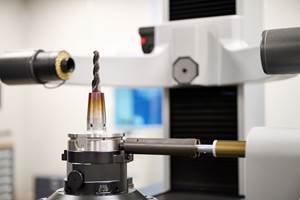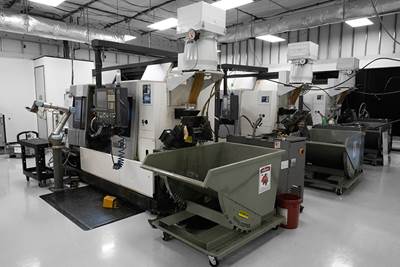Setting Up the Building Blocks for a Digital Factory
Woodward Inc. spent over a year developing an API to connect machines to its digital factory. Caron Engineering’s MiConnect has cut most of this process while also granting the shop greater access to machine information.
Share




Hwacheon Machinery America, Inc.
Featured Content
View More






Reeves says that MiConnect has simplified the act of connecting machines to Woodward’s overall digital factory. When recently asked to connect one Colorado facility’s Okuma machines to the digital factory, two of Reeves team members had the machines connected and running within four hours. Images courtesy of Woodward, Inc.
Running a digital factory is a tricky task, however you define “digital factory.” At Woodward Inc., a manufacturing company that tackles energy control in both aerospace (think fuel management) and power generation, smooth operation of the digital factory means gathering real-time data from machines, making decisions from that data, and sending instructions back down to the shop floor. Not every machine the company has innately supports this concept, or at least not to the extent Woodward requires. The company long developed custom connectivity APIs to construct the information pipelines it requires, but this could mean over a year of effort for new machines and new controls. But over the past two years, this situation has changed with the implementation of Caron Engineering’s MiConnect.
MiConnect plays two major roles at Woodward. First, it connects data from the machines to Ignition, the company’s SCADA (supervisory control and data acquisition) software from Inductive Automation, and vice versa, enabling the digital factory concept. Second, the software streamlines the development of successful automation integrations, both directly through simplification of robot cell control and indirectly through revision control and facilitation of machine tool compensation features.
The Connection Between Woodward and Caron
Jason Reeves, manufacturing engineering manager at Woodward’s Rock Cut campus in Rockford, Illinois, says that the company has used Caron’s TMAC (Tool Monitoring Adaptive Control) and auto-compensation software programs since they launched a decade ago. The software programs, at their core, would eventually power MiConnect, he says, and he can chart the course of the software’s development through his interactions with Caron staff.
In particular, Woodward relied on Caron for the installation of a custom RFID tool management system onto the shop’s Okuma machines around 2019, with the Caron representative informing Reeves that the software he was using to program the custom system was a development prototype of MiConnect. When MiConnect finally launched several years later, Reeves says the team at Woodward was one of the first to fly to Caron’s headquarters in Maine for a training session.
Woodward’s Rock Cut team primarily uses Makino, Okuma and Studer tools for its high-tolerance, mid-volume workload, but also uses a Tsugami Swiss-type and other assorted machines for particular jobs. The team tried to interface these machines with Ignition, starting with the Makino machines, but transferring the exact data they wanted proved difficult. Coding custom connectivity to acquire the data from the Makino machines’ FANUC controls — and later, setting up two-way communication — took over a year of work. Crucial pieces of data were invisible from the user end, and the team would have to code without knowing if they were targeting the correct pieces of information. While the project was ultimately successful, it was impractical to repeat for the other types of machines — at least, not without software that could cut this engineering time. This is where Reeves says MiConnect proved itself.
Woodward uses multiple functions within MiConnect on its Okuma Multus machines. These include Caron Engineering’s ToolConnect and AutoComp functions. Neither are implemented in an off-the-shelf configuration, but are instead altered to fit Woodward’s needs. The company also uses MiConnect to program its machine tending robots, and tracks tool life through the software.
The Invisible Handshake
MiConnect offers plugins for multiple types of controls, flagging and mapping all the registry bits to which it has access for ease of use. Reeves says this makes building out Woodward’s digital factory project much smoother, shortening the process of building a bespoke connection solution for its machines to three months for its Okuma machines, and down to weeks for subsequent new machine and control types. He adds that MiConnect plugins are more fully featured than the shop’s custom project.
“MiConnect is the handshake at the floor level,” Reeves says, pointing to how it now connects the OSP controls of the Okuma machines to Ignition. This enables Reeves and his team to click on the linked machines to see their status in real time. It also enables two-way information control, which Reeves says the team uses in several ways.
For one, they can jump between programs or change parameters on the fly. The team can also set machines to swap between automation and manual modes at the push of a button. The connection also makes Caron Engineering’s auto-compensation software more powerful, as the team can use a probe — connected to MiConnect — to measure a completed part and feed measurements to the machine to power compensations as the next part is running.
The swift connectivity also applies to the robots Woodward uses for machine tending, again bypassing most of the engineering work because it is already built into MiConnect’s plug-ins. Programmers can implement robotic actions such as opening machine doors, interacting with the machine, removing the part and collet, scanning the area, and cleaning through single icons, which Reeves says is especially useful when programming the fleet of Universal Robots’ parts-handling robots servicing the team’s 17 Okuma Multus mill-turns.
While scripting is possible within MiConnect, Reeves says that the plug-ins are much faster. He compares the effect the software has had on the team’s automation integrations to developments in the 3D printing industry: his team has found it faster, cheaper and more effective.
Revision Control
For all his team found MiConnect easy to use, Reeves says that programming with it still requires skill. The control engineers still need to know how an operation plays out, even with the icon- and flowchart-based programming. On the opposite end of the spectrum, he also says that his team needs to know when to rein in a solution’s complexity, as it’s easy in automation to make something more complicated than necessary. While his experience is that getting his team up to speed with MiConnect was relatively simple, he notes that they do need to schedule time to stay on top of new features that Caron adds to the software.
These new features range from straightforward additions, such as expanded API compatibility, to more complex ones, such as the addition of revision control. Revision control has been especially important to Woodward, Reeves says, as the company maintains manufacturing facilities across the U.S. As Reeves and his team optimize Woodward’s robotics programming at the Rock Cut facility, they have had R&D versions, production versions and original versions of the programs spread across internal systems, which can fall out of sync across the company’s facilities. Revision control has helped them keep all these program versions organized, and ensures that new integrations can be simply updated from the original programming to the production versions.
“It’s a lot easier to get return on investment if you buy software with the product,” Reeves says, but this revision control bypasses a lot of the errors that could result from buying the two separate — issues both machine and human. “Everyone is going off the same sheet of music,” he says, making for a more harmonious factory and production process.
Related Content
ERP and Process Changes Increase Shop’s Revenue 64% YoY
Implementing ProShop has led to a massive process overhaul at Marzilli Machine. From 2020 to 2021, revenue increased 64% without capital investment.
Read MoreCan Connecting ERP to Machine Tool Monitoring Address the Workforce Challenge?
It can if RFID tags are added. Here is how this startup sees a local Internet of Things aiding CNC machine shops.
Read MoreERP Provides Smooth Pathway to Data Security
With the CMMC data security standards looming, machine shops serving the defense industry can turn to ERP to keep business moving.
Read MoreSimulation and Tooling Secure High-Value Work
Simulation software and careful attention to tooling parameters have enabled Major Tool to take on ambitious projects with its complex machinery.
Read MoreRead Next
From Process Monitoring to Quality Prediction Software
Even before inspection, Datanomix and Caron Engineering’s TMAC AI can extrapolate part quality from cut information. This information also helps shops push their tool life to its limits.
Read MoreManufacturer, Integrator, Software Developer: Wolfram Manufacturing is a Triple Threat
Wolfram Manufacturing showcased its new facility, which houses its machine shop along with space for its work as a provider of its own machine monitoring software and as an integrator for Caron Engineering.
Read MoreFour Questions (& Answers) About Data-Driven Process Improvement at CNC Job Shops
How can shops can make informed decisions using data-driven feedback to improve shopfloor efficiency and profitability? And how will these technologies differ between high- and low-volume production?
Read More











































